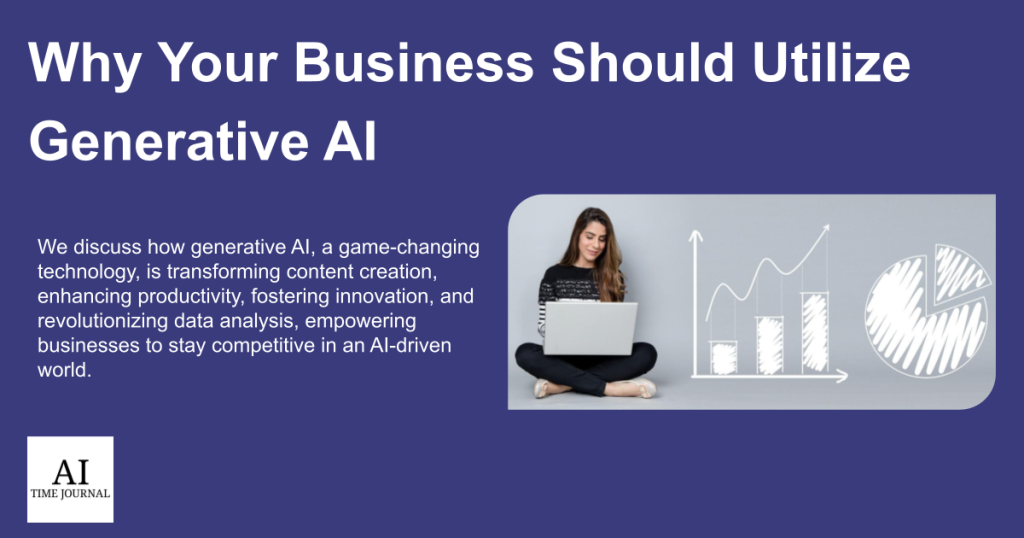
In this day and age of a fast-paced and digitally driven business landscape, the importance of Artificial Intelligence (AI) cannot be overstated. From enhancing operational efficiency to optimizing customer experiences, AI has truly become an indispensable tool for companies seeking a competitive edge. The remarkable frontier known as “generative AI” is emerging as businesses become more and more dependent on AI. Generative AI has the potential to completely transform how organizations use data and interact with it.
The next step forward in AI technology is generative AI, which is changing how businesses approach content creation, creative design, and problem-solving. Generative AI offers capabilities never seen before. This piece explores the explosive rise of generative artificial intelligence, analyzing its importance and the various ways it has the potential to transform various industries. Come along as we explore the strong arguments for your company utilizing generative AI in order to maintain its innovative edge and obtain a game-changing advantage in an AI-driven environment.
Table of Contents
- Understanding Generative AI
- Creative Content Generation
- Enhancing Productivity and Efficiency
- Innovation and Design
- Data Analysis and Decision Support
- Conclusion
Understanding Generative AI
Generative AI is a subset of artificial intelligence that focuses on creating content and data rather than simply processing or analyzing it. At its core, generative AI aims to generate new, original content, whether it’s text, images, music, or other forms of creative output. This technology creates creative, coherent, and contextually relevant material by utilizing deep learning techniques, particularly neural networks.
Here are just a few of the many core principles of generative AI to keep in mind:
- Neural Networks – Generative AI often employs neural networks, particularly recurrent neural networks (RNNs) and more recently, transformers. These networks enable the model to understand and replicate patterns, sequences, and relationships in data.
- Transfer Learning – When building on pre-trained models for particular tasks, generative AI models can make use of transfer learning. As a result, training data requirements can be greatly decreased, and efficiency can increase.
- Training on Massive Datasets – Generative AI models are trained on large and diverse datasets to learn from vast amounts of existing content. For instance, a text-based generative AI model might be trained on countless books, articles, and websites.
Generative AI is able to distinguish itself from other AI approaches by the primary function of creating new content and data. But most importantly what separates generative AI is its creativity, Traditional AI excels in well-defined tasks with explicit rules, whereas generative AI is creative and produces things that have never existed before. Generative AI’s ability to generate content, whether it’s text, images, music, or other forms of creative output is the reason why it gives businesses that adopt this technology a competitive edge. You may think of generative AI as the next evolution of artificial intelligence.
Generative AI encompasses a variety of components and technologies that enable the creation of content, whether it’s text, images, music, or other forms of data. For example, the training data required for generative AI data is a lot. For text generation, this might involve vast amounts of text from the internet. For image generation, it could involve databases of images. The quality and diversity of the training data significantly influence the model’s performance.
Creative Content Generation
Generative AI for text and written content creation has drawn a lot of interest and is being used in a variety of business contexts. This type of AI is capable of producing original work. Give generative AI a starting sentence, for instance, the iconic Star Wars line, “Once upon a time, in a galaxy far, far away.” With just a sentence, the AI can create a whole space adventure tale with characters, surprising turns in the storyline, and an exciting resolution.
Here are some examples of how this tool’s ability to create text content can be put to work for your business:
- Generative AI models, particularly those based on transformers like GPT (Generative Pre-trained Transformer), can be fine-tuned to generate articles, reports, and blog posts on specific topics. They can create content that is coherent and contextually relevant. Many news organizations and content platforms use AI-generated content to supplement human-written articles.
- The technology underlying chatbots and virtual assistants, such as voice-activated assistants and chat support on websites, is known as generative AI. These technologies improve customer service and user engagement by comprehending user questions and producing responses that seem human.
- AI models can generate translations for text from one language to another. They offer real-time translation capabilities for websites, apps, and communication platforms, bridging language barriers.
- Marketers use AI to generate social media posts, ad copy, and marketing content. AI-driven content generation can help maintain a consistent online presence and target specific audience segments effectively.
- By offering sentence completion suggestions, paraphrasing, or even creating full paragraphs, generative AI can help authors. This improves productivity, prevents writer’s block, and guarantees text consistency.
Generative AI is not limited to text content generation; it’s also playing a significant role in creating visual content, including images and videos, for businesses. Generative AI can be used to quickly generate mockups or prototypes for product design, packaging, or website layouts, helping businesses visualize their concepts. Or used to Graphic designers and creatives use AI tools to generate design elements, logos, and illustrations. Maybe not to solely create a logo for a company but it can assist in ideation and content creation for graphic designers. For example, Bing Chat GPT 4 has the ability for users to create logo concepts for their brands. In terms of working with video generative AI can improve video quality by reducing noise, enhancing colors, and stabilizing shaky footage.
Businesses operating in the branding and marketing domains are finding generative AI to be a useful tool. Businesses can generate marketing visuals with AI, allowing them to customize graphics, ads, and banners for different campaigns and audiences. But better, AI can analyze customer data to segment the audience effectively, allowing for personalized marketing campaigns. Then, businesses can also use AI to create dynamic content that changes based on user behavior or preferences, enhancing user engagement. Analyzing vast amounts of data to identify market trends and consumer sentiment, which is invaluable for adjusting marketing strategies is another tool generative AI brings to the plate in marketing.
Enhancing Productivity and Efficiency
By automating jobs, optimizing workflows, and providing creative solutions, generative AI is greatly increasing productivity and efficiency in a variety of industries. Automation has become a key driver of success in the modern business landscape, and generative AI is playing a pivotal role in achieving these goals.
Using task automation, generative AI is transforming productivity and efficiency in the following ways:
- Automating repetitive tasks like software can automatically extract, process, and enter data from various sources into databases or spreadsheets, reducing the need for manual data entry.
- Reducing errors and resource wastage, for example in manufacturing and production, AI-driven computer vision systems can meticulously inspect products, identifying defects and anomalies with a high level of accuracy. This reduces the likelihood of faulty products reaching customers and minimizes resource wastage.
- Within data analysis, AI systems are able to quickly process and examine big datasets, gleaning important patterns, trends, and insights. With AI able to make data-driven judgments in real-time, this feature is very useful in banking and other related areas.
- AI-driven systems streamline logistics and supply chain management by optimizing routes, minimizing shipping costs, and improving overall efficiency. For example, AI is a company investing in to help out in logistics optimization
Innovation and Design
Generative AI can be used to generate ideas for new product features, marketing campaigns, and branding concepts, among other business-related tasks. Businesses can utilize AI to generate creative suggestions by inputting particular prompts or inquiries. as was discussed with the Star Wars example previously in the text. This allows organizations to save a significant amount of time on brainstorming sessions while retaining human control over the final product, as generative AI only provides an early framework for your decision. • Creative design and prototyping
By automating and improving crucial stages of the product lifecycle, generative AI is dramatically accelerating the process of developing new products across a range of sectors. Once an idea is crafted, AI-powered technologies can swiftly produce prototypes and early designs. For example, generative AI may generate 3D models and apparel designs in the fashion industry based on design parameters, saving time compared to manual design effort. This means that generative AI can help your company come up with concepts for new products. AI can provide suggestions for products that are in line with the needs and preferences of customers by importing data on target audiences, market trends, and desired product attributes.
Data Analysis and Decision Support
Businesses in a variety of industries are changing the game thanks to generative AI’s capacity to examine massive information for insights. Generative AI can process large datasets for your company quickly and effectively, something that would be hard for humans to do by hand. This feature is especially helpful in sectors where enormous volumes of data are produced on a daily basis, such as banking, healthcare, and e-commerce. Besides providing insights from massive data sets, Generative AI is quite good at finding patterns and trends in data. Businesses can use it to make data-driven decisions by using it to find connections and anomalies that traditional analysis techniques might miss.
By analyzing historical data, generative AI can build predictive models that forecast future trends, customer behavior, and market dynamics. This is invaluable for optimizing inventory, demand forecasting, and personalized marketing.
Using generative AI driven by natural language processing (NLP), businesses may leverage unstructured text data from surveys, social media, and consumer reviews to make data-driven decisions. This gives companies the ability to discover new difficulties, assess public opinion, and learn more about the preferences of their customers. Businesses can track public opinion about their products or services by using generative AI, which can also identify the emotion conveyed in text data. It offers perceptions of the way consumers view the brand and its products.
Conclusion
More than just technical development, generative AI is a revolutionary force that is changing how companies run, innovate, and make data-driven decisions. With the digital landscape changing quickly and efficiency, creativity, and accuracy becoming more and more important, the advent of generative AI will have a significant impact on many different businesses.
Businesses may unleash the creative potential of generative AI by grasping its fundamental ideas, which include neural networks, transfer learning, and training on large datasets. This technology creates new and contextually relevant material in various formats, including text and images, going beyond simple data analysis. Generative AI produces content more creatively and efficiently, from writing blog posts and articles to optimizing client experiences with chatbots and translation services.
